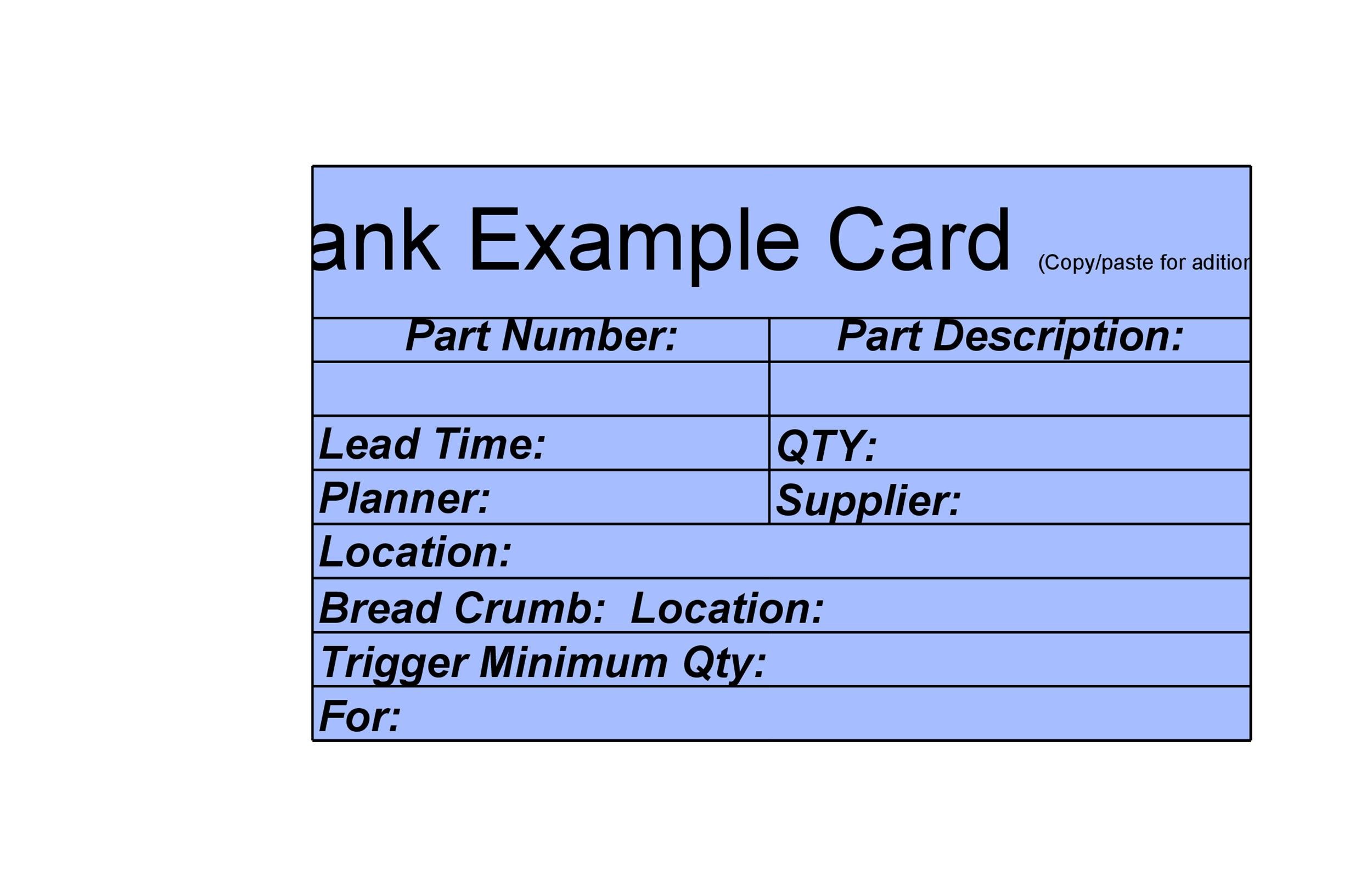We have to credit the Japanese for coming up with a scheduling system that, among other functions, can increase productivity and minimize waste in a manufacturing environment. Kanban improves manufacturing efficiency and the system takes its name from the cards that track production within a factory. In any of its manifestations, Kanban cards and boards have proven to be valuable tools in many production industries.
Table of Contents
Kanban Cards
What are Kanban cards?
Taiichi Ohno, an industrial engineer and businessman who is well-known as the father of the Toyota Production System, holds the credit with introducing the Kanban Cards system. The main purpose of this system is to manage the flow of parts in JIT or “just-in-time” production lines.
The term “Kanban” is a Japanese term derived from “kan” and “ban,” meaning visual and card respectively. Taken together, kanban roughly translates to mean “card you can see.” Ohno got his inspiration for developing Kanban card templates for the system when he noticed that the store shelves in a grocery store only had enough stocks to meet customer demand.
Also, the store’s inventory only got replenished if there were empty spots on the shelves. From this observation, Ohno came up with the idea of creating visual markers that could lessen unnecessary inventories. The system also helps discover and workflow process issues. These visual markers are the Kanban cards and because of their practicality, are still used today.
The origin of Kanban cards
The Kanban sheets and cards have a system that’s highly visual in nature. This makes it easier for teams in a company to communicate better regarding what work they need to do and when. As the Kanban evolved into a knowledge work system, the Kanban cards became representative of a separate work item.
There are no complicated processes involved with the use of Kanban cards and Kanban sheets. The most common way to display the “pieces of work” is by using sticky notes on a whiteboard with lanes to illustrate the steps the team needs to take in the process.
These simple notes contain vital information for each piece of work. The placement of the notes on the whiteboard defines the status of the work item visually within the process of the team. From this simple routine came the modern use of Kanban cards.
Why are Kanban cards so effective?
In designing the concept of Kanban cards, Ohno took into consideration the psychological and emotional aspects of change. To do this, Ohno formulated a set of guardrails that will guide actions to clarify what’s required to make the system effective and to empower those who contribute to it.
These guardrails are highly effective and are now part of the general practices and basic principles. These principles describe how and what you must think to become successful in managing for efficiency:
- Start with the information you know
The Kanban system is never about specific processes. Rather, it’s used to assess existing processes and so you don’t need to make any radical changes immediately. - Agree to follow incremental change
The Kanban method supports a constant change to the current system in place. But you have to make such changes gradually and in small increments. Drastic, wide-range or radical changes aren’t recommended as you might meet inevitable resistance. - Respect the current roles, processes, titles, and responsibilities
The Kanban method allows changes to the system, respects, and recognizes the fact that the current state of organization has value. The Kanban-style of incremental change can create broader implementation support because the small corrections that it introduces are more acceptable than a complete overhaul. - Encourage leadership acts on all of the levels
The Kanban method supports Kaizen, which is a Japanese business philosophy of continuous improvement of working practices, personal efficiency, and so on. It believes that anyone in the team can create great ideas, not just by management.
Kanban Card Templates
What to include on your Kanban cards?
The main purpose of Kanban cards is to visually convey a work item’s progress as it flows through a system or a process. To understand this better, you must know the most important characteristics of a Kanban card template. Here are some details of the card to help guide you as you create your own Kanban Excel template:
Face or Front
Since the main purpose of the card is a quick view of the work items’ visual status, the face or front should present details meaningful to your team and this information includes:
- A unique title or identifier
- A short description of the work
- An estimate of the work’s size
- The person assigned to the work
The information should fit on the front of the Kanban card template.
Back
As the card moves across the workflow, any of the team members can utilize the back of the template to write down applicable metrics including:
- Start date
- Blocked location and days
- Lead time
- Finish date
In a way, the card ultimately provides significant information about the overall workflow. With the card, you can understand not only the workflow of the system but also identify bottleneck any issues before they can have a significant impact on the system.
The information on the card also gives you an opportunity for continuous improvement. The accuracy of recording metrics makes the team realize the value of the Kanban system.
The general practices when using Kanban cards
For a Kanban system to work with maximum results towards a certain goal, there are some practices which describe the things you must do:
- Try visualizing the workflow
Kanban cards work effectively if you can visualize the whole workflow of your company. If you can visualize the number of requests, how much time it takes to deliver on the requests, who makes the risks and requests, then you may take the appropriate management steps as an individual and a team.
You can place Kanban sheets and cards on a Kanban board so that all the members of the team can stay on the existing workflow. - Limit work in progress
This is a very important cornerstone of the Kanban system. If you limit the work-in-progress, this forces your team members to concentrate on specific tasks for completion. This also highlights where work gets obstructed before a situation reaches a critical stage. - Manage the flow
Kanban can help in visually tracking and managing tasks to deliver maximum value. You can accomplish this based on the data you’ve collected on cycle time along with other metrics you agreed upon. Use the information regarding the recent state of work. - Make explicit policies
When teams work hand in hand, they create the fundamental rules about their workflows for various items and they decide when it’s time to move items into the next row or lane.
The teams also make their plans on how to take note of and deal with blocked tasks or work. Mark all of these items near the board for the team to work towards making improvements. - Apply feedback loops
It’s common for Kanban teams to have daily regular stand-up meetings with the Board to discuss ways on how to improve the delivery of tasks and the overall process and to determine where they can eliminate waste. - Work together for improvement
The Kanban system pinpoints areas in the process which call for improvement. Once determined, work groups develop ways on how to solve problems, hypothesize, then test their solutions.
By using the same general principles and practices, you can also apply the Kanban system in many business departments including:
- Audit teams
- Human resources
- Marketing project management
- Organizational executive and strategic leadership
- Task management
But for the Kanban system to succeed, the team must get deeply involved. Every member of the team should handle their assigned tasks within the established standards and follow the rules before turning over the task to the next team or individual. Furthermore, each member should keep the Kanban information updated and make this easily accessible to everyone
Kanban Excel Templates
Physical or virtual Kanban card templates
There are two ways to make a Kanban card template, you have the physical Kanban Excel template and the digital version. Many today prefer the virtual Kanban card template because of the features it has to offer. But keep in mind that either one can serve the same purpose.
- Kanban Card templates
Making a Kanban card template is one way of reducing these oversights in the work environment. Usually, however, all of the team members already have a consistent and clear understanding of their jobs, what they do, and what they still need to do. Even when there is a change in the work’s scope, the team members can always find ways to optimize the processes.
But as discussed earlier, the Kanban card template is a great tool in capturing and communicating this learning. For work based on repetition you can standardize the tasks with the use of Kanban sheets or card templates. This improves the process and throughout efficiently thus, saving time and resources. - Digital Kanban Card templates
This type of template provides easy and equal access for both onsite and remote team members. The automatic data collection feeds into charts and graphs for quicker data implementation. It also comes with stored history for the entire life of the card.































